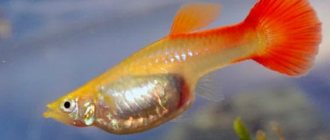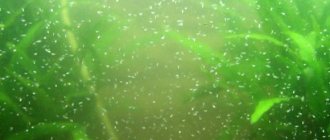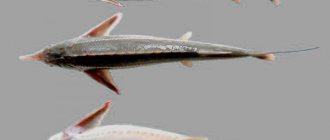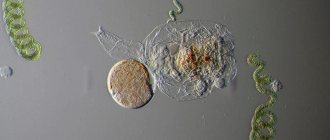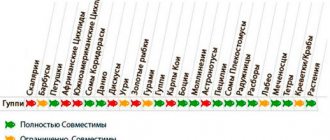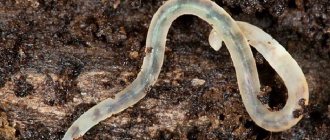Share this article:
The more aquarists practice keeping fish, the more extensive their knowledge, experience and skills become. Maintaining ideal conditions for their pets is no longer a difficult task, and there are often cases when breeders want to move to a new level - fish breeding, especially since the pets themselves favor this, making attempts to spawn in a common aquarium.
But “spawning” the fish and hatching the larvae is only 1/3 of achieving the goal – obtaining as many viable offspring as possible. Many aquarists, having acquired a horde of hungry and active babies, clutch their heads and do not know how to organize feeding in order to ensure their rapid growth and harmonious development. This is where the simplest and most common starter food comes to the rescue - “live dust”.
“Living dust” is a colony of harmless microorganisms common in many aquariums - shoe ciliates (lat. Paramaecium caudatum). In a container without decorations, you can see small white dots hovering in one place or making jerky movements.
Ciliates live in large numbers at the bottom, where they prey on bacteria that eat organic matter. These protozoa reproduce by division, which occurs once every 24 hours at a water temperature of 24-26 °C.
Ciliate slipper under a microscope.
Rotifers (lat. Rotifera) can also be used as “living dust”. These small (0.1-0.5 mm) multicellular predatory animals are found in all bodies of water and even puddles around the world. They feed in the same way as ciliates - various microorganisms.
Rotifer under a microscope.
What is it for?
For normal growth, fry must be well fed, but due to the structural features of the body, insufficiently developed internal organs and miniature size, traditional fish food intended for adults is absolutely not suitable for them. Therefore, for feeding, aquarists use specialized crushed food, better known as “live dust”.
This food can be purchased in specialized stores, but experts recommend breeding “live dust” at home, since it will be more nutritious, healthy, and most importantly – alive and absolutely natural.
Live dust at home
The smallest living food: ciliates, rotifers, as well as newly born crustaceans of Cyclops and Daphnia, they all together have the term “live dust”. Is it possible to breed the above-described organisms at home and combine them together to obtain an excellent starter food for fry?
Of course, it is possible, but not all of the listed types of food organisms that are part of live dust are equally suitable for breeding. And is it even necessary to try to breed problematic live foods?
What it is
First of all, it is necessary to understand what is meant by the definition of “living dust”. Essentially, it is crushed plankton. The product contains various components:
- Brackish water rotifer – has high nutritional and biological value. It is undemanding to environmental conditions and reproduces very quickly.
- Ciliates - the simplest unicellular organisms, most often used for feeding fry. They are formed in a nutrient medium, which you can create yourself using dried pumpkin, melon, banana peels, milk, lettuce leaves, carrots and yeast.
- Daphnia – valued for the high percentage of proteins needed by fry.
To feed young animals and produce “live dust,” you can use both the individual components listed above and their various combinations.
About the advantages and disadvantages
According to experienced aquarists, the advantages of “live dust” are:
- There is no risk of water contamination in the aquarium and water balance disturbance.
- Accelerated growth and development of fry.
- Absolute safety for both the fry themselves and other aquarium inhabitants.
- Simple and easy production at home, which even a beginner can handle.
- Affordable, affordable prices when purchasing ready-made food.
It is thanks to these advantages that “live dust” has gained wide popularity among aquarists. But this type of food also has a number of disadvantages:
- An unpleasant, specific aroma, especially characteristic of ciliates.
- The long time required for independent production of “living dust” (about 1-1.5 weeks).
- Difficulties associated with feeding. When feeding, it is very important to avoid getting rotten water, which is the medium for growing food, into the artificial reservoir.
But experts still recommend giving preference to live microorganisms rather than specialized dry food for feeding fry. This is due to the fact that calculating the optimal dosage of food is a rather difficult task, especially for novice aquarists.
An excess of food in the aquarium pollutes the water and has a bad effect on the condition of fry and other fish, green spaces, and algae, especially since growing young animals should be fed at least 6-8 times a day.
“Live dust” is completely safe, and even if it is not completely absorbed by the fry, over time it will be eaten by other aquarium inhabitants.
Description and characteristics of single-celled organisms
The ciliate slipper (Infusoria) belongs to the species Paramecium Caudatum.
These are single-celled protozoan animals with a microscopically small body size (0.1-0.35 mm); their species includes more than 8 thousand representatives. The reason for the peculiar name of the slipper ciliate was its appearance, whose outline resembles the sole of a shoe. The shoes' diet consists of microscopic algae and bacteria, which the ciliates pass through the body along with water. The slipper ciliate feeds in motion, its mouth is always wide open, and food particles gradually accumulate in it. According to biologists, ciliates evolved from flagellates of prehistoric times.
Over the entire surface of the ciliate’s body there are small rows of cilia, which serve as its kind of “fins”. In order for the ciliates to move from place to place, the cilia produce oscillatory wave-like movements.
The speed of the shoe is such that in one second it covers a distance fifteen times greater than the size of the ciliate itself. The habitat of these protozoa are natural and man-made freshwater ponds in which there is no current.
In such reservoirs there is a lot of organic matter, which decomposes and thereby provides the protozoa with enough food. The slipper ciliate even lives in home aquariums. It can only be seen under a microscope.
Did you know? A small aquarium fish of the guppy breed traveled to Earth orbit in the company of Russian cosmonauts aboard the Salyut 5 orbital station. The unpretentious and cute fish survived the flight well and returned safely to its native aquarium.
How to prepare “living dust”
In most cases, the production of “live dust” requires clean water, a container for it and certain elements. The nuances and features will depend on what kind of microorganisms the aquarist is going to grow, since each of them has its own specifics and needs.
"Live dust" from ciliates
“Live dust” based on ciliates is the most widespread and popular due to its excellent nutritional value and ease of preparation. For dilution at home, you need to prepare a sterile jar or bottle with a volume of about 3 liters. Fill the container halfway with boiled water, and then add an identical amount of liquid taken from the bottom of the aquarium.
After this, you need to put some yeast, dried fruits, and dried banana peels at the bottom of the container. There are no clearly established proportions, but you should not use too many nutrients, as this can lead to oxidation of water and the death of microorganisms. Finally, you need to add milk (5-6 drops) to the water.
The opened jar should be placed in a warm place, protected from exposure to ultraviolet rays. Add a few more drops of milk to the water once every 3-4 days. It is very important to keep the container open to allow sufficient oxygen to flow into it. Failure to comply with this key rule will lead to the inevitable death of microorganisms.
After a few days, the liquid will acquire a cloudy tint, and a specific film will form on the water surface, which indicates the active process of reproduction of bacteria, which are the main food of ciliates. When the water in the jar becomes clear again, we can assume that the process was successful; microorganisms have already managed to multiply and absorb the bacteria contained in the container.
At the same time, if you look closely, you will be able to see entire clusters of small white dots, which are “living dust.”
"Living dust" from a brackish water rotifer
The brackish water rotifer is unpretentious, reproduces quickly and is rich in nutrients. Therefore, it is often used to prepare “live dust”. To do this, you need to prepare a clean container with a volume of at least 1 liter and fill it with a solution of sea salt (at the rate of a tablespoon of salt per 1 liter of liquid). Additional aeration and maintaining an optimal temperature regime of about +26-30°C will also be required.
Yeast can be used as feed (hydrolysis or ordinary culinary yeast), in proportions - 1 tsp. for 20 liters of water. When adding fertilizer, the liquid becomes slightly cloudy, when the water becomes clear again - this indicates that it is time to add a new portion of yeast. Once a month you need to update the saline solution, approximately by 50%.
The brackish water rotifer is especially valuable for its amazingly rapid reproduction, since literally within 2-3 days you can already obtain a sufficient number of microorganisms for “living dust”.
Moreover, serving such food to fry does not require special preparation. Simply rinse the rotifer thoroughly with clean water and place it in the aquarium.
The disadvantages of this type of “living dust” include the fact that the lifespan of a brackish water rotifer is no more than 2-3 hours. Therefore, it is important to correctly calculate the dose of complementary food so that during this time it is eaten by fry or other fish. Otherwise, the reservoir will need to be cleaned and the water in it replaced.
"Live dust" from daphnia
To breed it you will need algae and green space. Place a fishing line in a separate aquarium, pour clean water, add a few drops of low-fat meat broth or other types of organic substances.
After which the container must be placed in a warm and well-lit place, and it is important to take into account that natural, sunlight is ideal for daphnia. After the fishing line becomes covered with green algae, it will need to be removed and thoroughly washed in the aquarium.
Pond dust
Pond dust is a natural, natural product that does not need to be specially diluted. It forms by itself in small puddles and small reservoirs. To harvest food, you simply need to collect it using a net made of dense material. This option is the simplest, but can be dangerous in terms of infection and contamination of the aquarium.
“Living dust” with rotifers
The most common rotifers in reservoirs do not exceed the size of ciliates, and their method of cultivation is identical, with the exception of a few nuances.
A rotifer culture can be obtained from prepared cysts purchased in a store or by taking a sample from a nearby body of water.
Make sure that crustaceans and insect larvae are not scooped up with the rotifers - these are their natural enemies.
During cultivation, diffused light is required - at least 10 hours a day. The lifespan of rotifers is about 4 weeks. After this period, it is recommended to replace most of the water in the jar and introduce new cysts.
How to properly serve “live dust”
The process of feeding the fry with “live dust” may initially seem somewhat complicated and will require a certain skill, which is developed with practice. The fact is that extracting microorganisms from a separate tank is a problematic task, and getting rotten water oversaturated with organic substances into the aquarium will be extremely unfavorable for both fry and other fish, especially small ones.
There are several methods of feeding “live dust”, but most aquarists prefer one – the simplest and safest. All you need for feeding is a little foam rubber or cotton wool, a disposable syringe without a needle and a test tube (can be replaced with any other container that has an oblong, elongated shape).
Next you need to follow the instructions step by step:
- Using a syringe, draw water from a jar that contains the microorganisms necessary for the fry.
- Fill the test tube 50% with the resulting liquid.
- Place a small piece of foam rubber or cotton pad on top.
- Pour clean water over the layer and leave for a while.
As a result, due to the lack of sufficient oxygen, microorganisms begin to rise upward, making their way through layers of cotton wool or foam rubber. At this stage, you will again need a syringe, with which clean water with “live dust” is collected and sent to the aquarium where the fry live. It is recommended to carry out this manipulation several times in a row.
Ciliates as food
As soon as an aquarist gains a little experience, he immediately tries to breed his pets on his own. When fry appear in the aquarium, the problem immediately arises of what to feed them. And only living dust (plankton) suits them. Experienced aquarists say that the size of food for fish larvae (fry) should not exceed the size of the fry's eye.
Infusoria Paramecium Caudatum is an excellent food for aquarium fry and is suitable for almost all types of adult aquarium fish.
Nutritional value of ciliates:
- protein - 58.1%;
- fats - 31.7%;
- ash - 3.4%.
Where to get
There are two options for providing your fish with fresh and nutritious live food:
- purchase live dust from pet stores;
- breed ciliates yourself;
- catch small plankton in the pond with your own hands.
In pet stores or aquarium stores, live dust is sold along with liquid, per liter. To keep the food alive, it needs to be purchased approximately twice a week.
If you decide to catch live dust yourself, you need to purchase a special net with synthetic or silk fabric. The sparseness of such tissue should be fairly dense; the cells should be no thicker than 0.1 mm.
After the first intake of water into the net, you need to examine the collected liquid under a magnifying glass to find out if there is at least some living creature in it. If it turns out that the plankton is alive, then you can continue catching live dust. During the filtering process, tiny plankton remains at the bottom of the net.
As a result of such fishing, your living dust will consist not only of slipper ciliates, but also of larvae (nauplii) of cyclops and rotifers. The entire catch is placed in a glass jar with water and brought home.
We invite you to familiarize yourself with the Domestic Goose: description and contents
Already at home, the brought live dust is once again filtered through nets with fabric of various densities. This will help sort the plankton by size. The caught plankton will remain alive for 5 days.
If you don’t have a great desire to run around ponds every week and look for food for your fish, then the best solution is to start breeding live dust at home.
Did you know? In the body of the slipper ciliate there are two nuclei: large and small. The large nucleus is responsible for movement and nutrition, and the small one is responsible for reproduction. Ciliates reproduce by division, and when this protozoan is ready to reproduce, its body stretches, forming a thin bridge in the middle, which eventually breaks. As a result of division, two adult individuals are obtained, which in due course will divide again.
How to breed
In order to start breeding ciliates at home, you first need to purchase material for propagating the culture. Where can I get it?
There are two options:
- ask for some slipper ciliates “for divorce” from a more experienced aquarist;
- catch it yourself in the pond using a net.
The best option is to take ciliates from a fellow aquarist. In order to scoop up more ciliates, water is taken from the very bottom of the aquarium, preferably closer to the algae growing at the bottom.
The breeding material taken from the aquarium will be clean, without foreign impurities. Indeed, in material taken from natural reservoirs, in addition to ciliates, various crustaceans are often found, which can destroy both shoes and fish larvae.
If you decide to get the material for breeding yourself, then you need to get to the nearest body of water and scoop up some silt and water from the bottom. Place your loot in a jar and take it home.
For further work, you will need a small, even glass (5 by 10 cm in size), a microscope or magnifying glass, a syringe (pipette, disposable syringe without a needle), and a sharpened thin stick.
We take a drop of water from a jar brought from the pond and place it under a microscope (magnifying glass). Considering all this wealth, we will see many different types of protozoa - among them you can easily identify the shoe.
Important! When independently catching plankton in natural reservoirs, the aquarist needs to remember that there may be parasites in the water (Dactylogirus and Gyrodactilus). These fluke parasites are not dangerous to tropical fish, but you still should not contaminate the water in the aquarium with them and it is better to avoid contaminated bodies of water.
Next, use a pipette to collect a drop of clean, non-chlorinated water and place it on the same glass, close to the drop from the pond. Our task is to select several individuals of slipper ciliates from lake water and move them to clean water.
If you don't have the skill to do this with a pipette, you'll need to do it differently. Using a sharp wooden stick, we connect both drops (lake and clean) with a thin water channel.
The shoes love fresh water and will immediately move into a drop of clean water. Other protozoa are not very keen on clean water, so it will be mainly the slipper ciliates that will move around. This procedure can be repeated up to a dozen times and obtain a shoe culture free from pests.
After this, the selected ciliates must be placed in an incubator jar for reproduction. Before moving live dust into the jar, you need to fill the jar with clean water to half the volume and place it in a well-lit place. An important point is that the jar should not be exposed to direct sunlight. To create a nutrient medium in the jar, you need to add a few drops of fresh milk (two to three drops).
We invite you to familiarize yourself with Milbemax for cats and kittens against worms
The temperature in the room where the incubator jar will be installed can be normal room temperature (20-22°C). If the goal of the aquarist is the rapid reproduction of live dust, then you just need to raise the temperature in the room to 26-28°C: this will speed up the reproduction process several times.
In a warm nutrient medium, the slipper ciliate begins to multiply quickly. As food for the protozoa, a small piece of organic matter is dipped into the water; the most massive accumulations of ciliates occur right around it.
If a film forms on the surface of the nutrient liquid over time, which prevents the flow of oxygen into the jar, then the protozoa accumulate closer to the neck of the jar.
To create a nutrient medium in an incubator jar, you can use not only milk, but also dry banana or pumpkin peels, hay infusion, pieces of fresh carrots or fish feed (in granules). When the nutrient solution matures, a not very pleasant smell of fermentation appears in the room.
The classic recipe for propagating slipper ciliates on a banana: The banana peel is dried and stored in a container that is hermetically sealed. When the time comes to breed the slippers, the dry peel is taken, rinsed under cold running water and placed in an incubator jar, which has previously been placed in fresh water and some water from the aquarium (containing ciliates).
For 6 liters of water, take 1/3 of the entire banana peel from one fruit. Next, as usual, the container is installed in a bright and warm place. During the process of reproduction, the number of ciliates will increase exponentially.
Their numbers peak at 14-21 days (depending on the room temperature) and will remain at a high level for 20 days. After this time, the amount of living dust in the jar will steadily begin to decrease.
If an aquarist urgently needs live food, and it is impossible to wait several weeks for reproduction, then the process can be accelerated. Place dry banana peels in a saucepan (the proportions are the same), pour boiling water over them, cover with a lid and leave until completely cooled naturally.
The cooled contents of the saucepan are added to a jar with water and plankton.
But the lifespan of the shoes obtained in this way is much shorter, so experienced aquarists add 3-5 of these jars at certain intervals. This helps to get an outbreak of live food by the desired date.
Recipe for infusion with milk: The second easiest way to prepare it is to infuse live dust with whole milk without sugar (cream skimmed from milk is also suitable). Milk is added weekly to a jar of shoes and water at the rate of one or two drops per liter. Ciliates feed on lactic acid bacteria.
Important! When adding fertilizer, it is important not to overdose. In case of an overdose, the bacteria will begin to multiply too quickly and absorb the oxygen intended for the ciliates. If the shoes are grown on bacteria, they have pronounced phototaxis (the desire for light).
Recipe for hay infusion: Take 10 g of dried and crushed grass (this is about two heaped tablespoons) and pour one liter of hot water. The mixture is brought to a boil, after which the heat is greatly reduced and the herbal infusion continues to simmer over low heat for 20 minutes.
We invite you to familiarize yourself with Foaming at the mouth of a cat: causes of pathology and actions of the owner
When the mood boils, all microorganisms are destroyed in it, but bacterial spores retain the vital activity. The same amount of non-chlorinated, settled water is added to the finished broth.
After three to four days, the bacterial spores will develop into bacilli. This will be food for the breeding ciliates-slippers. The infusion is added to an incubator jar, where living dust multiplies. To store the infusion on hay, choose a cool and dark place; the infusion will not lose its shelf life for 30 days.
Recipe on algae: Aquarists also breed slippers on chlorella and scenedesmus algae. A liter of algae is mixed with one pellet of carp feed. Ciliates that feed on algae cannot tolerate daylight (negative phototaxis).
This property of food with algae can be used when growing shade-loving aquarium fish or their larvae.
Another little-known method of propagating the slipper: After cleaning the aquarium, water collected from the bottom is poured into plastic bottles and placed in the sun. The water in the bottles turns green, and after a while the green settles to the bottom of the bottles. After this, you need to check the water with a magnifying glass for the presence of ciliates.
Additional recommendations
When feeding fry with “live dust”, it is important to adhere to a number of rules:
- Do not feed while the clock is spinning.
- Try to diversify the fry's diet using different types of live or prepared food.
- Feed the fry in small, fractional portions to avoid overeating, but do it often (up to 8-10 times a day).
- Arrange fasting days for young animals - once a week. According to experts, this will improve the digestive processes, well-being and vital functions of the fish.
“Live dust” is the best food option for fry, providing them with a range of useful nutrients.
=Live dust for fry=
Live dust for fry - breeding at home
When purchasing an aquarium and keeping fish in it, a novice aquarist usually does not think about what will happen next.
And then, as a rule, the following happens. For many, with proper maintenance of their aquarium pets, sooner or later, the fish begin to spawn and fry suddenly appear in your home pond. Here the question immediately arises: what should we feed such small inhabitants of the aquarium, especially during the first days of their life?
As you already understand, I was no exception, and at one time this question and task arose before me. I had to dig through a lot of information to solve this problem. And today, I want to share my experience.
Now, in pet stores you can find a variety of dry food, including for fry. That’s exactly what I used in the first couples. Tetra MinBaby is generally an excellent food for babies - a complete food in the form of micro-flakes, providing a complete diet for the daily nutrition and healthy growth of ornamental fish fry up to 1 cm in length.
At the same time, if you have the opportunity or you are raising fry of elite fish, then it is best to feed them with live food. This is due to the fact that the fry of many fish species eat only live prey, mainly because they do not perceive stationary food as food at all, at least at first.
No matter how wonderful store-bought dry food for fry is, live food will always be healthier and better. Dry food, in the form in which it is sold, cannot be given to fry; it must first be ground into dust and given in minimal doses so that the food is completely eaten and does not spoil the water, but this does not always work out. The fry should be fed 6–8 times a day. Agree, it’s not very convenient, especially when there are other responsibilities, for example, going to work))). What about live food? In articles about fish breeding, it is written that the starting food for fry is the so-called LIVE DUST (ciliates). This is what I started to build on!
What is this – living dust? And these are just the smallest microorganisms, among which there are ciliates. About 6,000 species of protozoa are classified as ciliates, one of which is the ciliate slipper.
The ciliate slipper (Paramaecium caudatum) is the simplest single-celled “animal”, its dimensions are 0.1 - 0.3 mm. Feeds on bacteria. It reproduces by dividing in two - approximately once a day, at a temperature of 24 - 26 ° C. It can be kept in any glass container at room temperature and diluted at home throughout the year. This is exactly what we will consider as starting live food for the fry.
There are a huge number of recipes and methods for breeding ciliates on hay, banana peels, yeast, dried fruits, vegetables, milk, etc. I’ll tell you about the easiest, in my opinion, method of breeding, which I used in practice.
To do this, we will need an infusoria incubator - plastic or glass containers of 3 liters or more. In my case, this is an ordinary 3-liter jar. Pour in 2-2.5 liters of boiled water at room temperature, put in a piece of dried banana peel and add 5 drops of milk (2-3 drops). Now all that remains is to add the ciliate culture. You can take it from friends who are experienced aquarists; just a few drops are enough. But I didn’t have such an opportunity, and I simply took a glass of water from the aquarium and added it to the jar - there are already a number of ciliates in the aquarium water. Then, he loosely covered the jar with a bag and placed it in a shaded place - under the table. That's all!
The next day, my jar became cloudy, which indicates that bacteria began to develop there, which is what the ciliates feed on. As mentioned above, ciliates reproduce by dividing in two once a day, so their numbers double every day. After about a week, the water in the jar cleared up and I saw a huge number of white moving dots - these are ciliates. You can start feeding the fry, but first I fermented another jar of live dust, taking an already existing colony of ciliates.
To feed live dust, I used an ordinary 2-cc medical syringe. I took the jar out of the shadows while all the ciliates were on top, near the surface, and carefully selected them with a syringe and poured them directly into the aquarium with the fry. Try not to shake the water in the jar in order to prevent a large number of bacteria from entering the aquarium; this can adversely affect the fry, even to the point of complete death. As the liquid with live dust is used up, it is necessary to add fresh boiled water at room temperature or old water from the aquarium to the jar to the required amount. Also, you should not forget to feed the ciliates once every 2-3 days, with 3-4 drops of milk. In addition to banana peels and milk, other food ingredients, such as vegetable skins and/or dried fruits, etc., can be added at the same time. The more varied these ingredients are, the more nutritious the living dust is.
